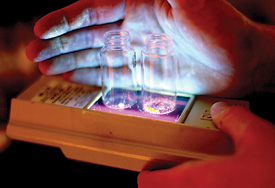Pure organic compounds that glow in jewel tones potentially could lead to cheaper, more efficient and flexible display screens, among other applications.
U-M researcher Jinsang Kim and his colleagues have developed a new class of material that shines with phosphorescence — a property that previously has been seen only in nonorganic compounds or organometallics.

Organic phosphors developed at U-M could one day lead to cheaper organic light-emitting diodes. Here, they glow in blue and orange when triggered by ultraviolet light. Photo by Marcin Szczepanski, College of Engineering.
Kim and his colleagues made metal-free organic crystals that are white in visible light and radiate blue, green, yellow and orange when triggered by ultraviolet light. By changing the materials’ chemical composition, the researchers can make them emit different colors.
The new luminous materials, or phosphors, could improve upon current organic light-emitting diodes (OLEDs) and solid-state lighting. Bright, low-power OLEDs are used in some small screens on cell phones or cameras. At this time, they aren’t practical for use in larger displays because of material costs and manufacturing issues.
The OLEDs of today aren’t 100 percent organic, or made of carbon compounds. The organic materials used in them must be spiked with metal to get them to glow.
“Purely organic materials haven’t been able to generate meaningful phosphorescence emissions. We believe this is the first example of an organic that can compete with an organometallic in terms of brightness and color tuning capability,” says Kim, an associate professor of materials science and engineering, chemical engineering, macromolecular science and engineering, and biomedical engineering.
This work is newly published online in Nature Chemistry.
The new phosphors exhibit “quantum yields” of 55 percent. Quantum yield, a measure of a material’s efficiency and brightness, refers to how much energy an electron dissipates as light instead of heat as it descends from an excited state to a ground state. Current pure organic compounds have a yield of essentially zero.
In Kim’s phosphors, the light comes from molecules of oxygen and carbon known as “aromatic carbonyls,” compounds that produce phosphorescence, but weakly and under special circumstances such as extremely low temperatures. What’s unique about these new materials is that the aromatic carbonyls form strong halogen bonds with halogens in the crystal to pack the molecules tightly. This arrangement suppresses vibration and heat energy losses as the excited electrons fall back to the ground state, leading to strong phosphorescence.
“By combining aromatic carbonyls with tight halogen bonding, we achieve phosphorescence that is much brighter and in practical conditions,” says Onas Bolton, a co-author of this paper who recently received his doctorate in materials science and engineering.
This new method offers an easier way to make high-energy blue organic phosphors, which are difficult to achieve with organometallics.
Former doctoral student Kangwon Lee discovered the unique properties of these materials while developing a biosensor — a compound that detects biological molecules and can be used in medical testing and environmental monitoring. The phosphors have applications in this area as well. After Lee’s discovery, Bolton developed the metal-free pure-organic phosphors.
The paper is titled “Activating efficient phosphorescence from purely-organic materials by crystal design.” Additional U-M contributors are former postdoctoral researcher Hyong-Jun Kim in the Department of Materials Science and Engineering and recent Chemical Engineering graduate Kevin Y. Lin.

